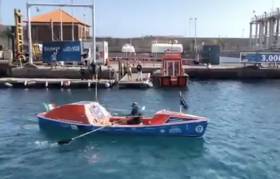Displaying items by tag: Atlantic Race
Atlantic Rower Damian Browne Arrives in Antigua to Big Welcome
#Rowing: Damian Browne has completed the Atlantic Challenge Rowing race. The big Galway man, a former professional rugby player, took 63 days to row from the Canary Islands to Antigua. He suffered through storms and capsizes and posted Facebook videos which showed the injuries he suffered. Rowing as Gulliver’s Travels, he was the final boat of the race to finish. He was greeted by a big group of green-clad Irish fans on land.
Irish On Track in Ocean Rowing Race
#Rowing: Irish boats are making progress in the Atlantic Rowing Race. Damian Browne, who was tested by difficult conditions and seasickness in the first two days, reported on his Facebook page that he has recovered. By 6pm on Monday he had rowed 154 nautical miles (285 kilometres) of the 2,700 nm/5,000 km journey from the Canary Islands to Antigua.
Relentless, the Cork/Dublin four, were making good speed closer to the head of the field. They were adjudged to be sixth overall. Home to Portrush, tracking further south, placed eighth.
Irish Battle Through Illness and High Winds in Ocean Race
#Rowing: Irish crews competing in the Atlantic Challenge race from the Canaries to Antigua have had to battle seasickness and strong winds in the first two days. Relentless, a four, and Gullivers Travels (crewed by Damian Browne) both started well. However, Browne had to deploy the para anchor and was very disappointed with his progress in the first 24 hours when he struggled with blisters, cramps and dehydration. Relentless were reported to have deployed an emergency beacon, though this was apparently done inadvertently.
The crews were showing steady progress on Saturday, as was the third boat from Ireland, Home to Portrush, which has taken a more southerly course.
Irish Crews Set off on Atlantic Rowing Race
#OceanRowing: Damian Browne has just set off to row the Atlantic. The former professional rugby player, in his boat Darien, left today from La Gomera in the Canary Islands to embark on the Atlantic Challenge race to Antigua. The fours, Relentless, from Cork and Dublin, and Home to Portrush, went off before solo oarsman Browne, who was the last of the 25 boats to leave today.
The start of the race had been delayed for two days because of high winds.


























































